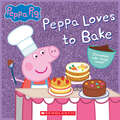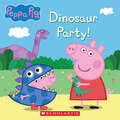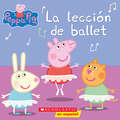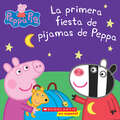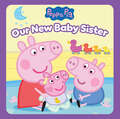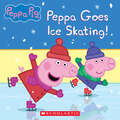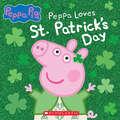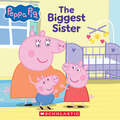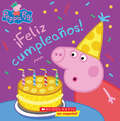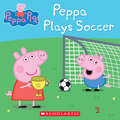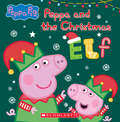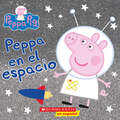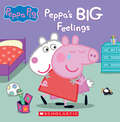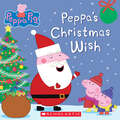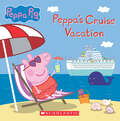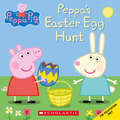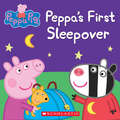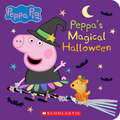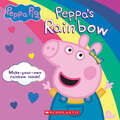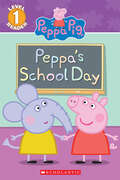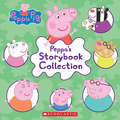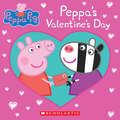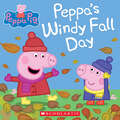- Table View
- List View
Peppa Loves to Bake (Peppa Pig)
by EOnePeppa and George love to bake in this sparkling storybook! Based on the hit TV show on Nick Jr.Peppa and George are making yummy cake for Miss Rabbit's baking competition. It tastes wonderful . . . but will they win? Find out in this adorable (and sweet!) storybook.
Peppa Pig: Dinosaur Party (Peppa Pig Ser.)
by Vanessa MoodyPeppa and George join Granny Pig for an epic Dinosaur Party! Based on the hit TV show.Granny Pig is throwing a dinosaur party and Peppa and George are invited! Will they have a roaring good time? Find out in this storybook based on the hit TV show!
Peppa Pig: La lección de ballet (Peppa Pig Ser.)
by Elizabeth SchaeferA ballet-themed 8x8 storybook featuring Peppa -- a lovable, slightly bossy little piggy!The Spanish edition of Peppa Pig: Ballet Lesson! Peppa Pig goes to her very first ballet lesson where she learns a graceful dance routine. But when Peppa decides to teach Mummy Pig and Daddy Pig how to dance, too, she finds out they might just have some dance moves of their own!La cerdita Peppa asiste a su primera clase de ballet, donde aprende elegantes pasos. Pero cuando intenta enseñárselos a su mamá y a su papá, ¡descubrirá que ellos ya tienen su propio estilo de baile!
Peppa Pig: La primera fiesta de pijamas de Peppa (Cerdita Peppa Ser.)
by ScholasticA sleepover-themed 8x8 storybook featuring Peppa -- a lovable, slightly bossy little piggy!Peppa Pig is going to her very first sleepover at Zoe Zebra's house. Suzy Sheep, Rebecca Rabbit, and Emily Elephant will all be there! But with so much slumber party excitement, will Peppa and her friends be able to fall asleep? Find out in this adorable 8x8 storybook based on the hit Nick Jr. show!La Cerdita Peppa va por primera vez a una fiesta de pijamas con sus amigas. Pero con tanta emoción y diversión, ¿podrán dormir Peppa y sus amigas? Descúbrelo en este adorable libro basado en la serie de Nick Jr.
Peppa Pig: Our New Baby Sister
by Cala SpinnerPig changes are coming in this sweet storybook!It's almost time for Peppa and George to meet their new sibling! What will the baby's name be? What will they like to do? Learn all about the new baby with Peppa and George!
Peppa Pig: Peppa Goes Ice Skating (Peppa Pig Ser.)
by Vanessa MoodyPeppa learns to ice skate in this sweet storybook! Based on the hit TV show.Peppa and her family are going ice skating together! All of Peppa's friends are there, and she is super excited. The only problem is... Peppa does not know how to ice skate! Will Peppa be able to find her stride and join the fun? Come along with Peppa and friends as they glide the day away!
Peppa Pig: Peppa Loves St. Patrick's Day
by ScholasticPeppa learns about and celebrates St. Patrick's Day in this original 8x8 storybool. Includes a special fact sheet in the back. Based on the hit show on Nick Jr.Peppa and George are going to Ireland for an Irish-dancing festival!But when the band forget their instruments, will Peppa's new Irish four-leaf clover be able to bring them some luck?This brand-new story features a glittery cover and is the perfect introduction to Ireland and St. Patrick's Day for little Peppa fans.
Peppa Pig: The Biggest Sister
by Cala SpinnerPig changes are coming soon for Peppa!There is going to be a new baby in the family, and that means Peppa is going to be the biggest sister! But what does that mean, anyway? Find out with Peppa!
Peppa Pig: ¡Feliz cumpleaños! (Peppa Pig Ser.)
by Annie AuerbachCelebrate Peppa's birthday in this charming storybook, then decorate the exclusive Peppa Pig birthday card inside!¡La version en espanol de Peppa Pig: Happy Birthday!Peppa invita a sus amigos a una fiesta de cumpleanos muy especial que incluye un espectaculo de magia protagonizado por el Increible Misterio, tambien conocido como Papa Cerdito. ¡Descubre las sorpresas que esperan a Peppa en su cumpleanos!Peppa invites her friends to a very special birthday party, complete with a magic show by The Amazing Mysterio -- also known as Daddy Pig. Find out what birthday surprises are in store for Peppa!
Peppa Plays Soccer (Peppa Pig Ser.)
by ScholasticPeppa and her friends play a lively game of soccer--but will both teams play fair?Peppa, George, and their friends get together to play a game of soccer: the boys against the girls! But what happens when the two teams can't agree on what's fair?
Peppa and the Christmas Elf (Peppa Pig)
by ScholasticCome on a Christmas adventure with Peppa in this festive new hardcover storybook, complete with a shiny cover!It's the most magical time of the year, and Peppa makes a wish: to have an adventure with an elf from Santa's workshop!When mysterious things start happening all around her, Peppa thinks it's the work of a mischievous elf! Can Peppa find out what's really going on?
Peppa en el espacio (Cerdita Peppa Ser.)
by Reika ChanPeppa Pig visits the museum with her family and learns all about outer space in this adorable 8x8 with stickers and glitter all over the cover! Based on the hit TV show, as seen on Nick Jr.¡Preparate para una historia de la Cerdita Peppa fuera de este mundo! Peppa, George, Mama Cerdita y Papa Cerdito visitan el museo para aprender sobre el espacio exterior. ¡Y dan un viaje ficticio al espacio y llegan a la Luna! ¡Con brillo plateado en la portada, este libro de cuentos atraera la atencion de los fanaticos de Peppa y sus padres!Get ready for a Peppa Pig story that's out of this world!Peppa, George, Mummy Pig, and Daddy Pig visit the museum to learn about outer space. They take a pretend trip through the planets, all the way to the moon! With silver glitter on the cover, and a sheet of stickers, this paperback storybook is sure to grab the attention of Peppa fans and their parents!
Peppa's Big Feelings (Peppa Pig)
by ScholasticPeppa Pig has big feelings, just like you! Find out all about them in this adorable paperback storybook!Come along with Peppa Pig and all of her friends as they each display a different type of emotion -- from anger to sadness to frustration and excitement. Readers will instantly relate to each character's struggles and learn how to manage their own emotions with this interactive read-aloud.PEPPA PIG and all related trademarks and characters TM & © 2003 Astley Baker Davies Ltd and/or Entertainment One UK Ltd. Peppa Pig created by Mark Baker and Neville Astley. HASBRO and all related logos and trademarks TM & © 2024 Hasbro. All rights reserved. Used with Permission.
Peppa's Christmas Wish (Peppa Pig Ser.)
by ScholasticCelebrate Christmas with Peppa, a lovable, slightly bossy little piggy! Based on the hit animated preschool show on Nick Jr.Now available in e-book!Snuggle up with Peppa Pig in this 2-in-1 wintertime storybook! It's Christmas Eve, and Peppa is hoping for a very special gift from Santa Claus. Will her wish cometrue? Then, Peppa and George decide to build a great, big snowman. This charming book includes two stories.
Peppa's Cruise Vacation (Peppa Pig Storybook)
by EOnePeppa and George are going on a cruise vacation in this adorable 24-page storybook!Anchors away! Join Peppa and her family on a cruise ship adventure with lots of fantastic stops along the way. What will Peppa and George discover on their trip? This storybook is based on the hit television show, as seen on Nick Jr.
Peppa's Easter Egg Hunt (Peppa Pig)
by ScholasticPeppa and her friends go on an Easter egg hunt adventure!It's springtime, and Grandpa Pig has set up an Easter egg hunt for Peppa Pig and her friends! Join Peppa, Rebecca Rabbit, and Freddy Fox as they search for delicious chocolate eggs and even see baby chicks hatching in the yard!
Peppa's First Sleepover (Peppa Pig)
by Scholastic EoneA sleepover-themed 8x8 storybook featuring Peppa -- a lovable, slightly bossy little piggy! Peppa Pig is going to her very first sleepover at Zoe Zebra's house. Suzy Sheep, Rebecca Rabbit, and Emily Elephant will all be there! But with so much slumber party excitement, will Peppa and her friends be able to fall asleep? Find out in this adorable 8x8 storybook based on the hit Nick Jr. show!
Peppa's Halloween Party (Peppa Pig Ser.)
by ScholasticJoin Peppa and her friends for a spooktacular Halloween party!It is the spookiest time of year! Peppa and her family play outside in the leaves, carve pumpkins, and dress up in costumes for a Halloween party with all of their friends!
Peppa's Magical Halloween (Peppa Pig)
by ScholasticJoin the spooky fun with Peppa and friends in this Halloween board book!It's Halloween at playgroup, and there's so much to do! Peppa and her friends are going to make a wand, pretend to fly on a broom, and mix up a magic potion. Will Peppa find real magic on Halloween? Find out in this illustrated storybook that's perfect for Peppa's youngest fans!
Peppa's Rainbow (Peppa Pig)
by EOnePeppa visits the biggest, most colorful rainbow ever in this gorgeous 8x8 storybook with a special fact sheet! Based on the hit TV show as seen on Nick Jr.Peppa loves rainbows! She and her friends will discover how rainbows are made in this storybook with a special fact sheet. Will they find a treasure at the rainbow's end?
Peppa's School Day: La Jornada Escolar De Peppa / Peppa's School Day (Scholastic Reader, Level 1)
by Meredith RusuIt's time for Peppa to go to school--and make a new friend!There's a new student in Peppa's class! Her name is Emily Elephant. At first, Emily is very shy and quiet. Peppa helps her adjust to school and make new friends as they learn, play games, and of course, jump in muddy puddles!
Peppa's Storybook Collection (Peppa Pig)
by ScholasticFans will teasure this beautiful hardcover collection of seven charming Peppa Pig stories in one book! Seven Peppa Pig stories in one book! In this timeless storybook treasury, enjoy seven charming tales about everyone's favorite little piggy, Peppa! From Peppa's first sleepover party to the adventures of Princess Peppa and Sir George the Brave Knight, this collection of classic stories is sure to delight any Peppa Pig fan. This collection includes: The Story of Peppa Pig, Best Friends, George Catches a Cold, Princess Peppa, George's New Dinosaur, Peppa's First Sleepover, and Playtime for Peppa and George.
Peppa's Valentine's Day (Peppa Pig)
by Courtney CarbonePeppa Pig learns about Valentine's Day and celebrates with her friends. Based on the hit animated TV show, as seen on Nick JrPeppa Pig gets a pretty card in the mail from Zoe Zebra. It's a Valentine's Day card! Peppa learns about the meaning of Valentine's Day and decides to show all of her friends just how special they are to her.This storybook is based on the hit animated TV show, as seen on Nick Jr.
Peppa's Windy Fall Day (Peppa Pig Ser.)
by ScholasticA fall-themed storybook featuring Peppa--a lovable, slightly bossy little piggy!It is a windy fall day--perfect for playing outside and jumping in big piles of colorful leaves! Join Peppa and her family as they enjoy outdoor fun in the crisp, autumn air in this delightful storybook based on the hit show--now in ebook!
Pepper & Poe
by Frann Preston-GannonMaurice Sendak Fellowship Award Winner Frann Preston-Gannon makes her US picture book debut with this hilarious yet touching story about two soon-to-be sibling cats, Pepper & Poe.Pepper is an old cat. He's set in his ways, and used to his normal routine in the house that he rules--or thinks he rules, anyway! Yup, he's got everything down to a science, including how to manipulate the house dog. That is until a new kitty named Poe comes along and starts messing up everything! Can Poe get Pepper to accept him as part of the family? This hilarious story reinvents the age-old new sibling topic with a furry twist, taking an emotionally heavy subject and masking it with humor--all while reinforcing the days of the week! Frann Preston-Gannon, the 2011 Maurice Sendak Fellowship Award Winner, makes a stunning US picture book debut with her unique, eye-catching artwork and clever use of text.
